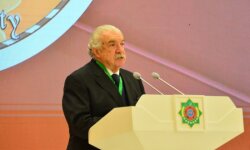Particular attention will be paid to preserving biological diversity of the territories and inscribing the Tura deserts on the UNESCO World Heritage List.
 The Turkmenistan authorities focus on preserving biological diversity and developing ecosystem services frameworks of the deserts of the country. Particular attention is paid to expanding the network of nature reserves, creating oases and developing the lands around the man-made lake in the Karakum Desert. The CentralAsia.news editorial staff summarized the work done.
The Turkmenistan authorities focus on preserving biological diversity and developing ecosystem services frameworks of the deserts of the country. Particular attention is paid to expanding the network of nature reserves, creating oases and developing the lands around the man-made lake in the Karakum Desert. The CentralAsia.news editorial staff summarized the work done.
Recently, the implementation of the regional project “Central Asian Desert Initiative – Conservation and Sustainable Use of the Deserts of Turkmenistan” has been discussed at the Ministry of Agriculture and Environmental Protection. The programme is jointly implemented with the Michael Succow Foundation, the University of Greifswald and the Food and Agriculture Organization of the United Nations (FAO).
The main goal of the project is to develop desert ecosystems of Turkmenistan and prepare a nomination dossier of the Turan deserts for the inscription on the UNESCO World Heritage List.
Chairperson at Ekodurmush public organisation Aynabat Ataeva noted that the Turkmen authorities applied a systematic approach to address environmental issues inside the country and abroad.
She emphasised that the measures aimed at stopping the desiccation of the Aral Sea and reviving once the world’s 4th largest lake had a special place in environmental protection activities. She says that a sandy salt desert with a surface area of more than 5.5 million hectares has appeared in place of the Aral Sea, which deteriorates the ecological situation in Central Asia.
“The ambitious project of Turkmenistan aimed at improving the ecological situation – the man-made Altyn Asyr Lake located in the north of the country is to address several environmental, economic and social problems,” the expert said.
She noted that vast areas of the Karakum desert were once considered unsuitable for agriculture and used for grazing. The use of powerful machines, including machinery for levelling and preparing land, has made it possible to grow fodder and other crops on these areas.
“New roads, water conduits and new settlements are built in the Karakum Desert each year. Small-scale livestock farms in the desert have transformed into quite large settlements. The belt of oases is being built along the Karakum Canal,” Ataeva said.



